Physical Address
304 North Cardinal St.
Dorchester Center, MA 02124
Mitral regurgitation (MR) and mitral stenosis (MS) may result from abnormalities of the mitral valvular complex—leaflets, annulus, chordae, and papillary muscles—and the left atrium and ventricle.
Intraoperative echocardiography is a vital diagnostic technique for mitral valve (MV) surgery and is recommended for all valve repair procedures. Three-dimensional (3D) echocardiography, with or without color Doppler, may aid the clinician in localizing valvular pathology before and after cardiopulmonary bypass.
The alterations in loading conditions resulting from general anesthesia and positive-pressure ventilation have dramatic effects on indices of MR and MS severity. The high-flow state after the use of cardiopulmonary bypass may falsely raise pressure gradients across prosthetic mitral valves.
Each prosthetic valve type (i.e., mechanical or biological) has unique echocardiographic patterns on transesophageal echocardiography (TEE) after bypass.
Epicardial echocardiography may be employed by the surgeon to evaluate the MV in its dynamic state if questions still exist about the mechanism of MV dysfunction after sternotomy.
Residual MR after MV repair portends a poor prognosis. The location of MR (i.e., central or eccentric) and its mechanism (undercorrection of annulus, failure of neochords, residual leaflet abnormalities, repair breakdown, ring dehiscence, or systolic anterior motion [SAM]) are just as important as the degree of regurgitation.
Common prosthetic valve abnormalities are impairment of leaflet opening and closing (due to thrombus, pannus, calcification, or entrapment by subvalvular tissue) and paravalvular regurgitation. Native mitral tissue left after valve replacement has the potential to create SAM. Small paravalvular leaks after valve replacement usually resolve after heparin reversal.
One key to successful communication between the echocardiographer and the surgeon is to make sure they speak the same procedural language. A structure may be named differently depending on the anatomic terms of reference used. For example, the lateral and medial commissures are sometimes referred to as the anterior and posterior commissures, respectively. Whereas the echocardiographer readily identifies the annulus as the hinge point at the base of the leaflets, the surgical identification is the level of the visible transition between the left atrial (LA) myocardium and the denser white leaflet ( Fig. 22.1 ). When communication is optimal and the echocardiographic assessment is consistent, superior outcomes may result.
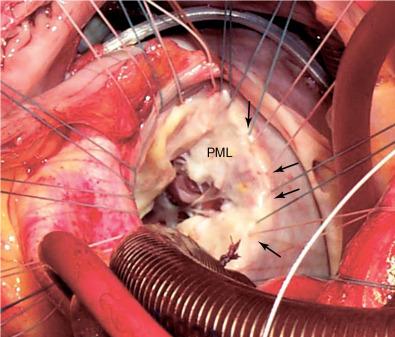
The anterior leaflet is intimately associated with the aortic-mitral curtain and is sometimes referred to as the aortic leaflet. At the outside margins of the aortic-mitral curtain lie the fibrous trigones, which are important surgical landmarks. The posterior leaflet may be referred to as the mural leaflet, due to its proximity to the left ventricular (LV) wall. The classification endorsed by the American Society of Echocardiography and Society of Cardiovascular Anesthesiologists is shown in Fig. 22.2 . From left to right (or lateral to medial), the posterior leaflet is divided into scallops P1, P2, and P3, and the corresponding segments of the nonscalloped anterior leaflet into segments A1, A2, and A3. Deviant clefts are found in up to 30% of posterior leaflet specimens.
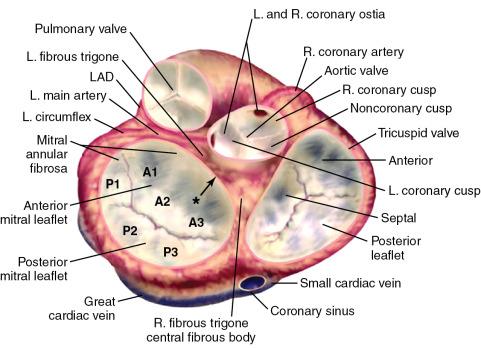
The intraoperative setting can be daunting, even to experienced practitioners who do not spend the bulk of their clinical time in the operating room. Numerous factors constrain optimal image acquisition, including bright lights and noise. Time may be limited because several different physicians and nurses have responsibilities in surgical preparation and the surgical procedure. If feasible, the echocardiographer should request that room lighting be dimmed or, at a minimum, that any overhead surgical lighting be directed away from the echocardiographic system screen.
Most general anesthetic medications diminish vascular tone and decrease contractility. Patients are often taking preoperative vasodilator medications such as angiotensin-converting enzyme (ACE) inhibitors and angiotensin receptor blockers (ARBs). The echocardiographer must take the effects of decreased afterload into account when quantifying the degree of mitral regurgitation (MR). Positive-pressure ventilation and cardiopulmonary bypass have numerous hemodynamic effects with the potential to alter echocardiographic findings.
After the surgical procedure commences, electrocautery is used, which causes interference with the quality of two-dimensional (2D) echocardiography, spectral Doppler echocardiography, and especially color-flow Doppler imaging data. Electrocautery also creates stitching artifacts during multiple-beat acquisitions on three-dimensional (3D) transesophageal echocardiography (TEE). The distortion of the electrocardiogram may prevent appropriate triggering of cine loop recording from the QRS complex; instead, the echocardiography instrument should be set to store data for a set length of time (e.g., 2 s), rather than a set number of beats. The use of electrocautery may preclude the use of 3D multibeat acquisition modes.
The variety and acuity of diagnoses of patients coming to the operating room for treatment of valve disease has increased considerably as surgical options and the timing of surgery have changed over the past few decades. , Patients may require repeat surgery because of complications from a previous valve replacement (i.e., operative or interventional) or repair.
Remaining uncertainties after preoperative evaluation should be defined, with a plan for their resolution. Along with clinical data and results from other imaging modalities, the preoperative transthoracic echocardiography (TTE) data should be reviewed; if possible, the actual images should be examined to assess data quality. If, as often occurs, previously undiagnosed pathology is discovered on TEE, this information should be promptly shared with the surgeon.
A comprehensive baseline intraoperative TEE examination is recommended to confirm or refute the mechanism and severity of the MV abnormality, assess valve reparability, and provide comparison images for the postoperative evaluation. The baseline TEE examination includes 2D, spectral, and color-flow Doppler studies with quantitation of mitral stenosis (MS) and MR using standard approaches (see Chapters 15 and 16 ). 3D imaging, if available, enhances the understanding of abnormal mitral function.
Secondary effects on other structures, specifically the left-sided chambers and the tricuspid valve, may help determine the chronicity of the process. Some lesions are often associated primarily and secondarily with MV disease ( Table 22.1 ), and they may require correction at the time of mitral surgery. Of paramount importance is recognition of the profound impact that alterations of loading conditions and ventricular function can have on the severity of MR.
| Secondary Condition | Preoperative Significance | Postoperative Significance |
|---|---|---|
| Pulmonary hypertension | May indicate LV failure, LV outflow tract obstruction, aortic valve disease, severe mitral regurgitation | Aortic valve surgery may be needed. Pharmacologic therapy may be needed. |
| Right heart failure | Often due to elevated left-sided filling pressures | Aggressive pharmacologic support may be needed. |
| Tricuspid regurgitation | Often due to elevated left-sided filling pressures; consideration for reparative procedure at time of mitral surgery | Must be differentiated from primary tricuspid valve disease |
| Mitral leaflet systolic anterior motion | Consideration for reparative procedure (i.e., myomectomy) | Aggressive pharmacologic manipulation may be needed; may necessitate valve replacement |
| Rheumatic valvular disease | Aortic stenosis, aortic regurgitation, tricuspid stenosis/regurgitation may necessitate intervention. Aortic regurgitation may confound mitral valve area calculation by the pressure half-time method. |
Reassessment of native valves or of repaired/replaced valves after mitral valve surgery is required. |
2D imaging allows assessment of the general condition of the leaflets, including the degree of thickness, mobility, calcification, and subvalvular disease. The LA is assessed for thrombus and ruptured chordae. The finding of LA or LV dilation may speak to the chronicity of the mitral abnormality, and it is assessed using published guidelines. Spontaneous echocardiographic contrast or “smoke” indicates relative stasis of blood in the LA; it is often seen in patients with significant MS and may portend a high likelihood of LA appendage thrombus. Detection of masses should alert the echocardiographer to the possibility of endocarditis, with the potential for extension, leaflet perforation, involvement of other valves, and pseudoaneurysm formation (see Chapter 25 ).
A systematic examination of the MV is performed next. Assessment plans have been described by Shanewise et al, Foster et al, Bhatia et al, and Hahn et al ( Figs. 22.3 and 22.4 ; Table 22.2 ). Hahn’s report combines a description of standard 2D and 3D views with a general summary of indications, contraindications, and training requirements for TEE. Using these guides, the intraoperative echocardiographer can recognize where the pathologic aspects of the valve lie. Basic views of the MV leaflets are obtained from a mid-esophageal position (see Fig. 22.4 ). As each view is obtained, slight movements of the probe—withdrawal and advancement, rotation left and right, and flexion and extension—are used to completely examine each leaflet segment. At this stage of the examination, color-flow Doppler imaging may be used, but this is more to help clarify the mechanism of MR ( Figs. 22.5 and 22.6 ).

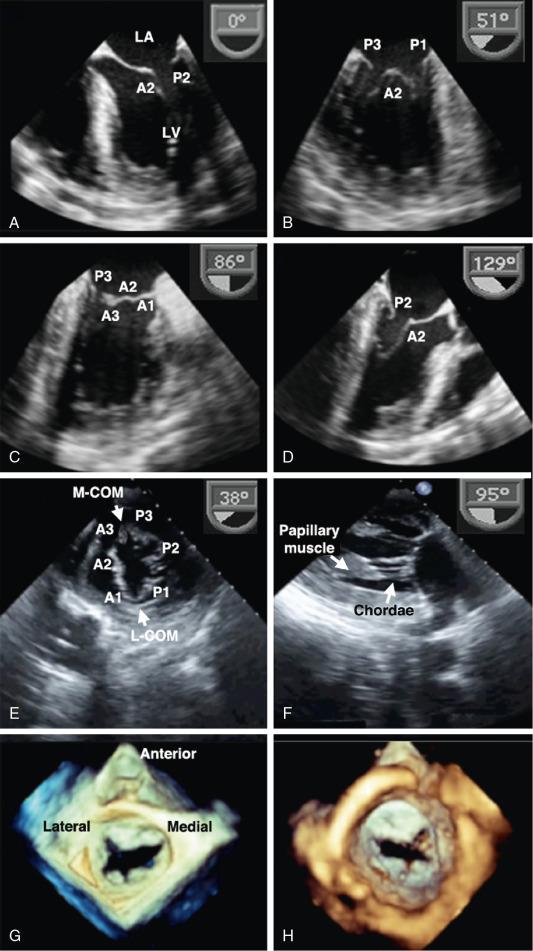
| Name of View | Description of View | 2D TEE Appearance |
|---|---|---|
| ME four-chamber view (≈0–10 degrees) | AML is on left side, adjacent to aortic valve. PML is on right side. Area of PML and AML that are visible are mostly P2 and A2. Probe flexion and slight withdrawal will bring A1 and P1 into view; retroflexion and slight advancement will bring A3 and P3 into view |
See Fig. 22.4 A and Video 22.4A |
| ME commissural view (≈50–70 degrees) | Two apparent coaptation points From left to right, visible mitral segments are P3, A2, and P1. |
See Fig. 22.4 B and Video 22.4B |
| ME two-chamber view (≈80–100 degrees) | Small P3 on left side and large AML on right side Segment that coapts with P3 is A3. Rest of visible AML varies. |
See Fig. 22.4 C and Video 22.4C |
| ME long-axis view (≈120–140 degrees) | PML on left side and AML on right side If plane of scan is centered, P2 and A2 are visible. May scan from side to side. |
See Fig. 22.4 D and Video 22.4D |
| TG short-axis view (≈0–20 degrees) | AML on left side and PML on right side Posterior commissure at top and anterior commissure at bottom |
See Fig. 22.4 E and Video 22.4E |
| TG two-chamber view (≈90–110 degrees) | Inferior wall at top Anterior wall at bottom Slight movement from side to side reveals papillary muscles and chordae. |
See Fig. 22.4 F and Video 22.4F |
| 3D LA view | This view looks down at the valve from the LA and is closest to the surgeon’s actual view of the valve. By convention |
See Fig. 22.4 G and Video 22.4G |
| 3D LV view | This view looks up at the valve from the LV apex. The AML is at top, and the PML is at bottom. |
See Fig. 22.4 H and Video 22.4H |
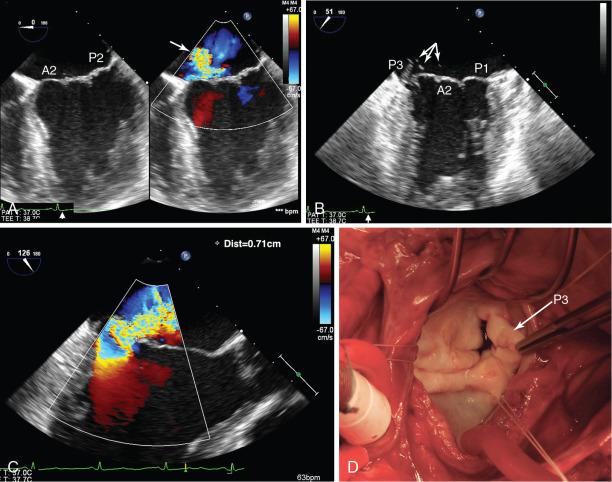
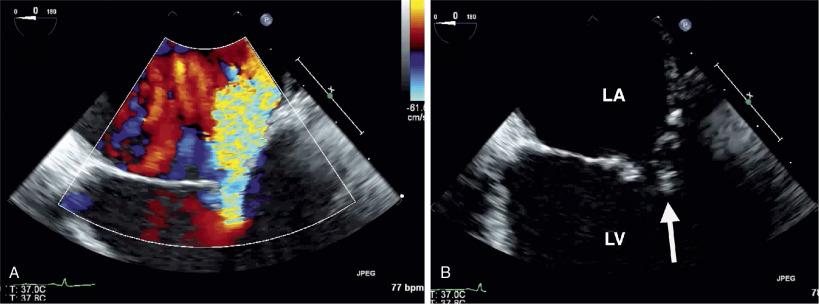
The subvalvular apparatus is best seen with transgastric views, which allow visualization of chordal thickening, redundancy, or frank rupture along with the orientation of the papillary muscles. On the basis of these images, the Carpentier classification can be used to define the mechanism and cause of MR, which may be helpful in planning the surgical approach ( Fig. 22.7 and Table 22.3 ).
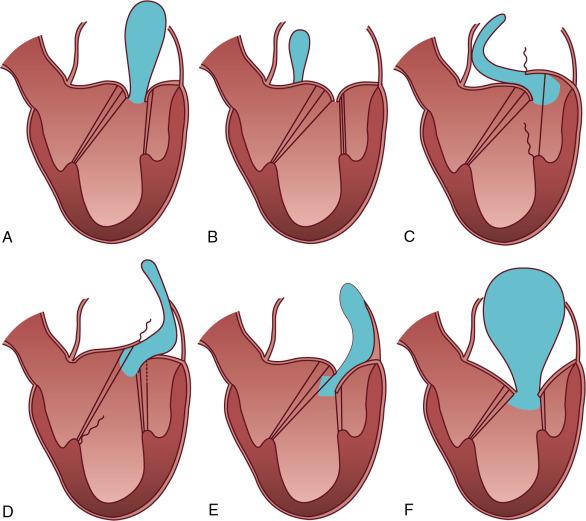
| Type of Mitral Regurgitation | Common Causes |
|---|---|
| Structural MR | Mitral valve prolapse Rheumatic disease Congenital valve disease Mitral valve endocarditis |
| Secondary MR | Ischemic heart disease Nonischemic dilated cardiomyopathy |
| MR associated with obstruction of left ventricular outflow tract | HCM Underfilled or hyperdynamic left ventricle (rare without HCM) After mitral valve repair (usually in the setting of underfilling/hyperdynamic states) |
Measurement of annular diameter guides the surgeon in the selection of a prosthesis or annuloplasty ring. The saddle shape of the annulus is demonstrated with 3D reconstructions (see Fig. 22.4 ). The low points of the saddle are at the commissures, seen in the commissural view, and the high points are in the anteroposterior axis, seen in the mid-esophageal long-axis view.
On the basis of comparison with cardiac computed tomography, the best approach for annular measurement is the commissure-to-commissure peak systolic diameter in the TEE commissural view the and anteroposterior diameter in the long-axis view. This may also be accomplished with 3D imaging with or without the use of mitral reconstruction software. The annulus is also assessed for the degree of calcification, which may predict paravalvular leaks, perioperative stroke, and whether extensive annular debridement is performed; it is also assessed for left ventricular rupture at the atrioventricular groove and for left atrial dissection.
Examination of global and segmental LV function is also needed in the evaluation of the mechanism of MR. Secondary MR is caused by global or regional LV systolic dysfunction or by altered LV geometry. However, chronic primary MR also leads to LV dilation with the potential for progressive LV dysfunction (see Chapter 5 ), which may complicate the perioperative management of MV surgery.
If TEE images are suboptimal, the surgeon can employ the technique of epicardial echocardiography before and after cardiopulmonary bypass. A transthoracic probe is placed inside a sterile sheath, which is then placed directly on the heart. Most standard transthoracic views can be obtained, with excellent resolution. The use of 3D epicardial echocardiography has been shown to be both feasible, an productive of high-quality images.
Numerous reports have described techniques for intraoperative 3D acquisition and assessment. Potential benefits include a mechanistic explanation of a given patient’s MR, better assessment of the pathologic components of the valve that need to be addressed surgically, evaluation of MV repair and replacement, and localization of postprocedural leaks.
Although 3D TEE is commonly used in a complementary fashion to 2D TEE, few studies have attempted to define the incremental value added by 3D TEE. Although few would dispute that intraoperative 3D TEE for MV surgery is an established technique, no amount of perioperative imaging can make up for inadequate surgical exposure.
Grewal et al compared 2D TEE and 3D TEE in the setting of MV surgery and found that the two methods were equally reliable in diagnosing the cause; however, 3D TEE had greater sensitivity and specificity for disease involving the P1 segment of the posterior leaflet or the A3 segment of the anterior leaflet and for bileaflet disease. Similarly, Ben Zekry et al reported that the 2D and 3D methods of TEE were highly accurate in diagnosing mitral disease but that 3D TEE could localize the lesion more predictably. Both studies acknowledged the limitations inherent in such comparisons. Surgical observation is considered to be the gold standard even though it is performed with the heart in a flaccid state.
In an elegant study, Maffessanti et al evaluated a large group of patients with Carpentier type II disease and found improved localization of leaflet abnormalities with 3D TEE and a greater ability to define annular shape before and after surgical repair. Other studies have reported higher accuracy with 3D TEE in the evaluation of mitral pathology, especially when there was involvement of the commissures ( Fig. 22.8 ).
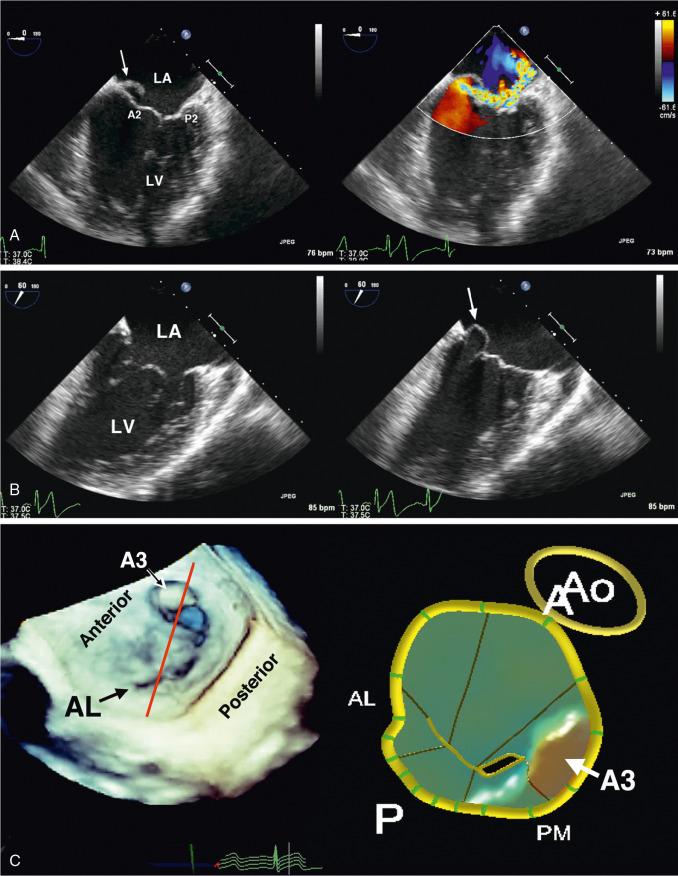
3D TEE has enhanced our understanding of mitral leaflet and annular mechanics and the ability to define complex lesions before and after bypass (see Chapter 2 ). The valve can be imaged from the LA and LV sides. MV quantification software may improve the ability to fully define MV lesions and may help the surgeon better plan the procedure : what to resect, the shape of annular ring to choose, and the predicted effect of remodeling procedures such as papillary muscle repositioning. The limitations on the use of 3D TEE in the operating room are related to the negative effect of electrocautery on multibeat acquisition and the lower resolution compared with 2D TEE. The two techniques remain complementary.
Become a Clinical Tree membership for Full access and enjoy Unlimited articles
If you are a member. Log in here